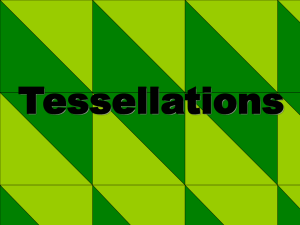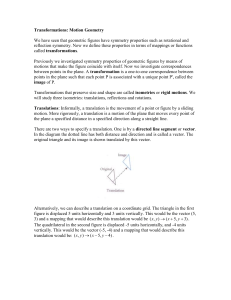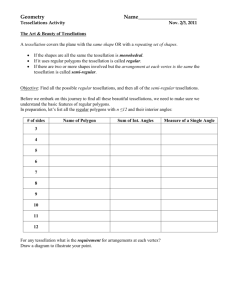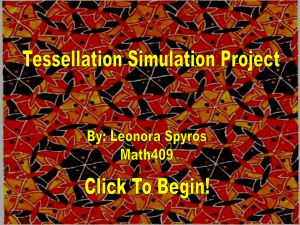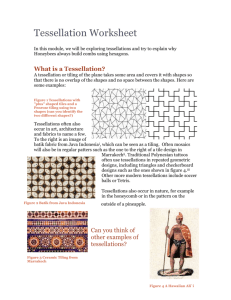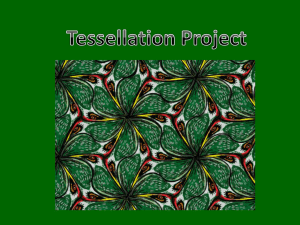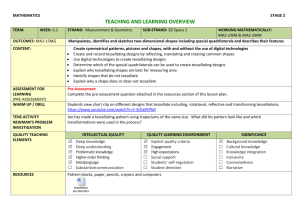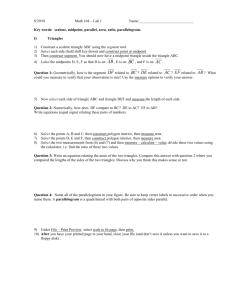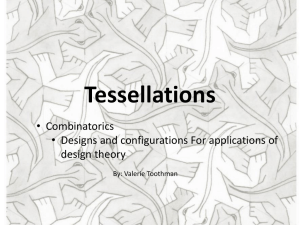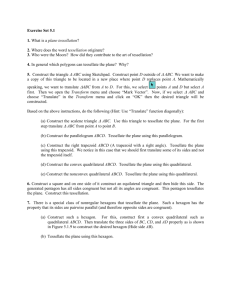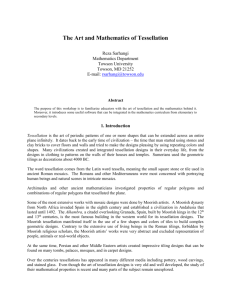Overview - Connecticut Core Standards
advertisement
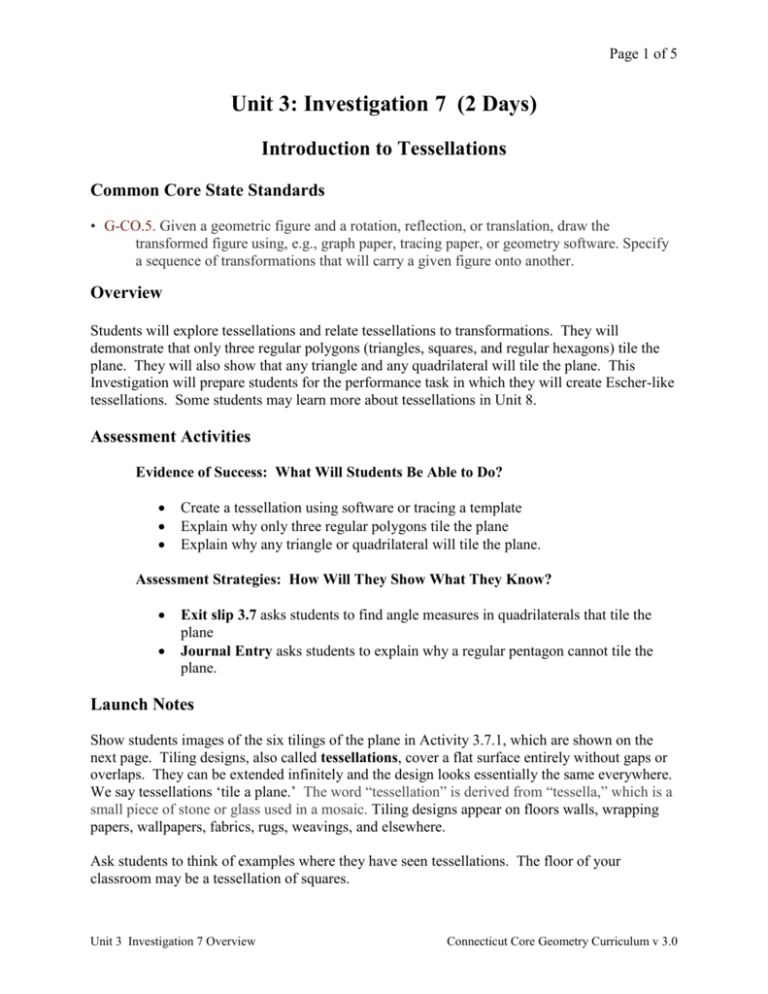
Page 1 of 5 Unit 3: Investigation 7 (2 Days) Introduction to Tessellations Common Core State Standards • G-CO.5. Given a geometric figure and a rotation, reflection, or translation, draw the transformed figure using, e.g., graph paper, tracing paper, or geometry software. Specify a sequence of transformations that will carry a given figure onto another. Overview Students will explore tessellations and relate tessellations to transformations. They will demonstrate that only three regular polygons (triangles, squares, and regular hexagons) tile the plane. They will also show that any triangle and any quadrilateral will tile the plane. This Investigation will prepare students for the performance task in which they will create Escher-like tessellations. Some students may learn more about tessellations in Unit 8. Assessment Activities Evidence of Success: What Will Students Be Able to Do? Create a tessellation using software or tracing a template Explain why only three regular polygons tile the plane Explain why any triangle or quadrilateral will tile the plane. Assessment Strategies: How Will They Show What They Know? Exit slip 3.7 asks students to find angle measures in quadrilaterals that tile the plane Journal Entry asks students to explain why a regular pentagon cannot tile the plane. Launch Notes Show students images of the six tilings of the plane in Activity 3.7.1, which are shown on the next page. Tiling designs, also called tessellations, cover a flat surface entirely without gaps or overlaps. They can be extended infinitely and the design looks essentially the same everywhere. We say tessellations ‘tile a plane.’ The word “tessellation” is derived from “tessella,” which is a small piece of stone or glass used in a mosaic. Tiling designs appear on floors walls, wrapping papers, wallpapers, fabrics, rugs, weavings, and elsewhere. Ask students to think of examples where they have seen tessellations. The floor of your classroom may be a tessellation of squares. Unit 3 Investigation 7 Overview Connecticut Core Geometry Curriculum v 3.0 Page 2 of 5 Unit 3 Investigation 7 Overview Connecticut Core Geometry Curriculum v 3.0 Page 3 of 5 Teaching Strategies Now have students work on Activity 3.7.1 Noticing Tessellations. Following this activity lead the class in a discussion to arrive at a properties of tessellations. They may generate a list similar to this: (1) (2) (3) (4) It is made of congruent figures. Only one figure (or a small number of figures) are used. There are no gaps between the figures. Three or more figures meet only at a vertex, thus we don’t consider this pattern to be a tessellation: Note, however, that some authors do not agree and will classify the above pattern as a tessellation. (5) The tessellation continues indefinitely and fills the entire plane. Group Activity Activity 3.7.1 lends itself to group work. Students work in pairs or groups of 3 or 4 to answer the questions. Then they share their results with the entire class in coming to a consensus about the properties of tessellations. Following agreement on what constitutes a tessellation, students are ready to work on Activity 3.7.2 Regular Tessellations. This activity builds on what students learned about the interior angles of a regular polygon in Investigation 4. It culminates in a proof that there are only three types of regular tessellations. By examining possible sums of angles at a vertex, this proof foreshadows that proof in Unit 6 that there are only five regular polyhedral. Differentiated Instruction (For Learners Needing More Help) Give students templates of the three regular polygons (or pattern blocks) so they can experience concretely the ability of these polygons to fill the space around a vertex. Semi-regular tessellations, which involve more than one type of regular polygon, are studied in Unit 8. Following this activity, the journal prompt may be assigned. Unit 3 Investigation 7 Overview Connecticut Core Geometry Curriculum v 3.0 Page 4 of 5 Journal Entry Explain why a regular pentagon cannot tile the plane. Look for students to explain that the measure of its interior angle, 108°, is not a factor of 360°. The focus of Activity 3.7.3 Tessellating Triangles is to show that any triangle will tessellate the plane. There are two arguments that can be used to establish this fact. The first revisits the proof of the Triangle Sum Theorem in Investigation 1. The original triangle was translated twice; once by the vector from B to A and once by the vector from C to A. If the points A’ and A1’ are now joined, ∆AA’A’1 is congruent to ∆ ABC by SAS. The parallelogram AB1’A1’A’ (or hexagon CBB1’A1’A’C’) can then be translated repeatedly in several directions to fill the plane. The second approach is to rotate a triangle 180° about the midpoint of one side. The triangle and its image form a parallelogram, which can be translated to fill the plane. This approach introduces 180° rotation as a method to get a side to correspond with it image. The same approach is used in the next activity to tessellate any quadrilateral. Activity 3.7.4 Tessellating Quadrilaterals completes the investigation. Because the sum of the interior angles is 360° copies of each of the four angles of a general quadrilateral will fit around a vertex. To get the to do so, one quadrilateral is rotated about the midpoint of one side. The original quadrilateral and its image can both be translated so that four copies of the quadrilateral share a vertex. The composite figure, which may contain as many as 8 sides, may be translated repeatedly to fill the plane. Both Activities 3.7.3 and 3.7.4 may be done with Geogebra or GSP. Another approach is to give students templates of scalene triangles and irregular quadrilaterals and have them trace them to show how a tessellation may be formed. Differentiated Instruction (Enrichment) Students who investigated non-convex quadrilaterals earlier in the unit may want to observe that they can also tile the plane. Using software, create a tessellation with an irregular convex quadrilateral. Then move one of the vertices in the original quadrilateral so that it is non-convex. Observe that this quadrilateral still tessellates the plane. Analyze why this is, by considering that while the measure of one of the interior angles is greater than 180°, the sum of the four angles at a vertex remains 360°. The Exit Slip may be given after students have completed Activity 3.7.4. Unit 3 Investigation 7 Overview Connecticut Core Geometry Curriculum v 3.0 Page 5 of 5 Closure Notes Call attention to the tessellation of horses and riders in Activity 3.7.1. Unlike the others, the figure is not a polygon. Ask students to think about how the artist may have created this tessellation. Vocabulary Tiling Tessellation Regular tessellation Resources and Materials Activity 3.7.1 Noticing Tessellations Activity 3.7.2 Regular Tessellations Activity 3.7.3 Tessellating Triangles Activity 3.7.4 Tessellating Quadrilaterals Geogebra or GSP Scissors and Rulers to cut out templates Pattern Blocks Unit 3 Investigation 7 Overview Connecticut Core Geometry Curriculum v 3.0
